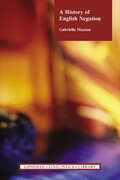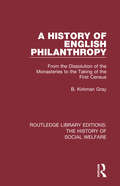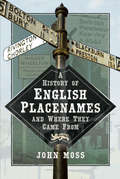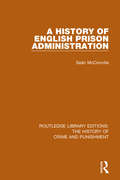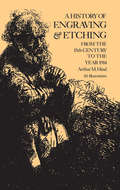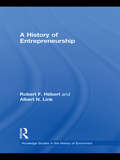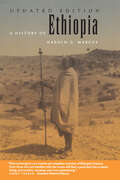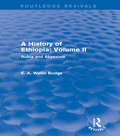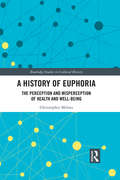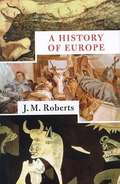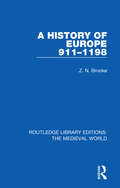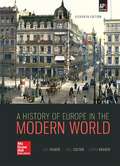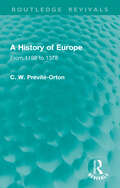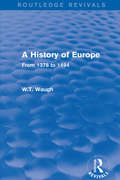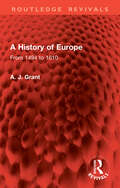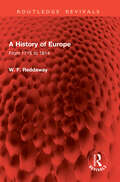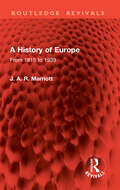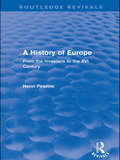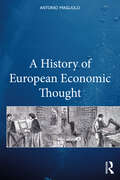- Table View
- List View
A History of English Negation (Longman Linguistics Library)
by Gabriella MazzonNegation is one of the main functions in human communication.A History of English Negation is the first book to analyse English negation over the whole of its documented history, using a wide database and accessible terminology. After an introductory chapter, the book analyses evidence from the whole sample of Old English documents available, and from several Middle English and Renaissance documents, showing that the range of forms used at any single stage is wider, and the pace of their change considerably faster, than previously commonly assumed. The book moves on to review current formalised accounts of the situation in Modern English, tracing the changes in rules for expressing negation that have intervened since the earliest documented history of the language. Since the standard is only one variety of a language, it also surveys the means of negation used in some non-standard and dialectal varieties of English. The book concludes with a look at relatively recently born languages such as Pidgins and Creoles, to investigate the degree of naturalness of the principles that rule the expression of English negation.
A History of English Philanthropy: From the Dissolution of the Monasteries to the Taking of the First Census (Routledge Library Editions: The History of Social Welfare)
by B. Kirkman GrayFirst published in 1905, this book charts the history of English philanthropy from the Elizabethan period through to the nineteenth century. In doing so, Benjamin Kirkman Gray posed some important questions about modern philanthropy, and reflected on the meaning and worth of philanthropy. Through historical study, the author discussed this complex question, which, in a time before the development of the British welfare state, was particularly topical. This book will be of interest to those studying the history of philanthropy, social welfare and poverty.
A History of English Place Names and Where They Came From
by John MossThe origin of the names of many English towns, hamlets and villages date as far back as Saxon times, when kings like Alfred the Great established fortified borough towns to defend against the Danes. A number of settlements were established and named by French Normans following the Conquest. Many are even older and are derived from Roman placenames. Some hark back to the Vikings who invaded our shores and established settlements in the eighth and ninth centuries. Most began as simple descriptions of the location; some identified its founder, marked territorial limits, or gave tribal people a sense of their place in the grand scheme of things. Whatever their derivation, placenames are inextricably bound up in our history and they tell us a great deal about the place where we live.
A History of English Prison Administration (Routledge Library Editions: The History of Crime and Punishment #6)
by Sean McconvilleThis title, first published in 1981, draws from an extensive range of national and local material, and examines how innovations in policy and administration, while solving problems or setting new objectives, frequently created or disclosed fresh difficulties, and brought different types of people into the administration and management of prisons, whose interests, values and expectations in turn often had significant effects upon penal ideas and their practical applications. Special attention has been paid to the study of recruitment, the work and influence of gaolers, keepers, governors, and highly administrative officials. This comprehensive book will be of interest to students of criminology and history.
A History of Engraving and Etching
by Arthur M. HindArthur Mayger Hind (1880–1957) was a leading historian of engraving, one of the most highly respected art historians of modern times. Keeper of Prints and Drawings at the British Museum and Professor of Fine Art at Oxford, he was the author of the most complete history of etching and engraving that has yet been written. This book, formerly out of print for many years, contains references to every etcher or engraver worthy of mention from the early fifteenth century to 1914, and it gives a fair account of influences, artistic repercussions, and accomplishments of each individual.Beginning with a chapter on processes and methods of the twin arts, in which he covers line-engraving, etching, biting and stopping-out, tone processes, the tools used in the various methods, and so on, the author proceeds with a text that is fabled among artists, art historians, teachers, and students for its richness of detail and the brilliance of its author’s obvious genius for research and criticism. He begins with the anonymous engravers of the fifteenth century, moves through Holland, Italy, and Germany to the great masters of engraving and the beginnings of etching in the sixteenth century, through the portrait engravers, master etchers, the practitioners of mezzotint, aquatint, crayon manner and stipple, and color print makers, to modern etching in the period prior to World War I. All along the way there are illustrations: over 100 magnificent works by Dürer, Finiguerra, Cranach, Lucas Van Leyden, Parmigiano, Van Dyck, Rembrandt, van Ruysdael, Blake, Tiepolo, Piranesi, Turner, Boucher, Goya, Millet, Whistler, and scores of others. All but seven of these plates have been reproduced from new photographs and are even sharper and clearer than those in the original editions of Hind's great text.As an aid to students of art history, there is a massive Index of more than 2,500 artists mentioned in the text, with their dates and brief individual biographical data. Furthermore, there is a classified chronological list, arranged by country, of important artists, movements, and styles, and the engravers and etchers who were influenced by them. Finally, there is a bibliography that is valuable for further reference work.
A History of Entrepreneurship (Routledge Studies in the History of Economics)
by Albert N. Link Robert F HébertThis book establishes a chronological trace of the entrepreneur as treated in economic literature in order to give a more wholesome perspective to contemporary writings and teachings on entrepreneurship. It focuses on the nature and role of the entrepreneur, and of entrepreneurship, as revealed in economic literature as early as the eighteenth century, when Richard Cantillon first coined the term 'entrepreneur'. The authors then trace how Joseph Schumpeter's perspective, among other’s, on entrepreneurship came to dominate the world's understanding of the term. Due to Schumpeter’s dominant influence, entrepreneurship has come to occupy a primary role in the theory of economic development. In this book Hébert and Link discuss various key topics including the German Tradition, the Austrian and the English School of thought as well as individuals such as Alfred Marshall and Jeremy Bentham. The historical survey also illustrates the tension that often exists between "theory" and "practice" and how it has been difficult for economic theory to assimilate a core concept that plays a vital role in social and economic change. Finally, the book exposes the many different facets of entrepreneurship as they have been perceived by some of the great economists throughout the ages.
A History of Ethiopia
by Harold G. MarcusIn this eminently readable, concise history of Ethiopia, Harold Marcus surveys the evolution of the oldest African nation from prehistory to the present. For the updated edition, Marcus has written a new preface, two new chapters, and an epilogue, detailing the development and implications of Ethiopia as a Federal state and the war with Eritrea.
A History of Ethiopia: Nubia and Abyssinia (Routledge Revivals)
by E. A. BudgeThis is the second volume of Sir E. A. Wallis Budge’s narrative account of Ethiopian history, and continues the chronicle of the Kings of Abyssinia where the first volume ended: the death of Lebna Dengel in 1540. The list of kings ends with the Regent Rās Tafari, who still reigned at the time of first publication in 1928. Thereafter, the author devotes considerable attention to an overview of the cultural, social and political idiosyncrasies of the Ethiopian people: literature, spells and magic, architecture, ethnography, the alphabet, and a wide range of other engrossing topics. This material complements the narrative history, helping to situate the deeds of the kings and the fortunes of their people in a broader context.
A History of Ethiopia: Nubia and Abyssinia (Routledge Revivals)
by E. A. BudgeThis, the first volume of Sir E. A. Wallis Budge’s The History of Ethiopia: Nubia and Abyssinia, first published in 1928, presents an account of Ethiopian history from the earliest legendary and mythic records up until the death of King Lebna Dengel in 1540. Using a vast range of sources – Greek and Roman reports, Biblical passages, Egyptian hieroglyphs, and Ethiopian chronicles – an enthralling narrative history is presented with clarity. This reissue will be of particular interest to students of Ancient Egyptian culture, religion and history.
A History of Euphoria: The Perception and Misperception of Health and Well-Being (Routledge Studies in Cultural History #67)
by Christopher MilnesVery few people have not at some point in their lives believed themselves or their loved ones to be reasonably healthy when, in "reality", sickness was encroaching or never went away. Health has been deceiving us for thousands of years, but rarely have we entirely dispensed with it as a concept. This book sets out to establish why and how that might be. The first of its kind, this longue durée historical study explores some of the ways in which people in western societies and cultures have come to believe that they, or other people, have perceived or misperceived health, well-being and euphoria—a word which, before the twentieth century, usually named the experience of health. This book draws from a number of areas of historical research, including the histories of convalescence, addiction, madness and Sigmund Freud’s interest in Euphorie in his pre-psychoanalytical period.
A History of Europe
by J. M. RobertsBeginning with its Paleolithic origins and the early civilizations of the Aegean, Roberts traces the development of the European identity over the course of thousands of years, ranging across empires and religions, economics, science, and the arts. Antiquity, the age of Christendom, the Middle Ages, early modern history, and the old European order all are surveyed in turn, with particular emphasis given to the turbulent twentieth century.
A History of Europe 911-1198 (Routledge Library Editions: The Medieval World #6)
by Z.N. BrookeOriginally published in 1938, A History of Europe 911-1198 is a comprehensive and scholarly history of Europe from the revival of the Empire under the German kings to the great religious and political conflicts of the late twelfth century. This book will be of interest to students and scholars of medieval history.
A History of Europe in the Modern World: AP Edition 11th ed
by R. R. Palmer Joel Colton Lloyd KramerCombining concise accounts of specific nations and national differences, with a wide-ranging, comparative analysis of international events, this updated edition of a classic text carefully examines the whole modern history of Europeans and their perpetually changing societies.
A History of Europe, 1648-1815
by Maurice AshleyA college level textbook on the history of Western Europe, with additional references for follow-up reading.
A History of Europe: From 1198 to 1378 (Routledge Revivals)
by C. W. Previté-OrtonOriginally published in 1937 and as a third edition in 1951, this volume discusses the development of Europe and its component states by focussing on events and institutions such as the monarchy, religious wars, the development of agriculture, feudalism, legal systems, chivalry and warfare, education and the arts and literature of the Middle Ages.
A History of Europe: From 1378 to 1494
by W.T. WaughFirst published in 1932, this book looks at a period that has often been thought of as a time of general decline in the most characteristic features of medieval civilisation. While acknowledging decline in many areas during this period — the power of the Church, feudalism, guilds, the Hanseatic League, the autonomy of towns and the end of the two Roman empires — the author argues that there was also signs of development. National consciousness, the power of the bourgeoisie and trade and industry all rose markedly in this period alongside intellectual and artistic achievements outside of Italy. This book asserts that in amongst the failure and decline new forces were creating new substitutes.
A History of Europe: From 1494 to 1610 (Routledge Revivals)
by A. J. GrantOriginally published in 1931 and as a fifth edition in 1952, this book became a classic survey of European history which focusses on the pan-European features and tendencies of the Middle Ages. The book also looks beyond Europe at the history of Islam and the conquest and discoveries of the European powers in the New World in relation to European affairs.
A History of Europe: From 1610 to 1715 (Routledge Revivals)
by W. F. ReddawayFirst published in 1948, this book provides a comprehensive overview of the history of Europe from 1610 to 1715. It discusses themes like the Europeans of 1610; Germany and the Netherlands in 1610; the Thirty Years War; the Westphalian Peace; Progress of Spain, England and the Dutch; England and the Spanish Succession; The Treaties of Utrecht; and Europe in Louis’ Last Years. This is a must read for students of European History.
A History of Europe: From 1715 to 1814 (Routledge Revivals)
by W. F. ReddawayFirst published in 1936, this book provides a comprehensive overview of the history of Europe from 1715-1814. The author discusses important themes such as England in 1715; European trade in 1715; the War of the Austrian Succession; Europe and American independence; eastern factor in Europe; Napoleon and the Continental System; Europe after the fall of Napoleon and diplomacy and war in Europe. The author argues that this book is a narrative of which collective Europe, not a group of separate nations, is the hero. Wherever possible, its political biography has been followed chronologically. This is an important historical reference work for students of European history, political history, and history in general.
A History of Europe: From 1815 to 1939 (Routledge Revivals)
by J. A. MarriottThis volume was originally published in 1931 and revised for the third edition in 1937. The critical events since that date necessitated a further revision, with a large amount of re-writing and the addition of new chapters which brought the book to the opening of the Second World War with a short summary of events between that date and the autumn of 1943. The author consulted newly accessible archives and primary sources and covers topics such as the European Monarchy, the European Revolutions, Diplomacy and War, and Peace Treaties and Conferences not just within European borders but against the global backdrop of international interests.
A History of Europe: From the Invasions to the XVI Century (Routledge Revivals)
by Henri PirenneFirst published in 1939, this is a reissue of Henri Pirenne's extremely popular and influential history of Europe in the Middle Ages. It begins with the Barbarian and Musulman invasions in the fifth century AD, which signalled the end of the Roman world in the West, and ends in the middle of the sixteenth century with the Renaissance and the Reformation. Universally praised for its detailed and impartial approach, this reissue will be very welcome news to both students of medieval history and to the general reader seeking a definitive review of the period.
A History of European Economic Thought
by Antonio MagliuloA History of European Economic Thought grafts the history of economic thought onto Global History by showing how significant economic ideas have influenced the process of Europe’s formation from the very beginning to the present day. This work combines two classical stories that until today have followed parallel paths. On the one hand, there is the political history of Europe, which is often limited to a few fleeting references to the ideas of the great economists of the past. On the other hand, there is the history of economic thought, which examines Europe as a whole, as a distinct supranational community, only with reference to the institutions created after World War II. The volume sheds light on the constitutive values of Europe, which also stem from a particular economic culture, and provides essential reading for students and scholars of the history of economic thought.
A History of European Women's Work: 1700 to the Present
by Deborah SimontonThe work patterns of European women from 1700 onwards fluctuate in relation to ideological, demographic, economic and familial changes. In A History of European Women's Work, Deborah Simonton draws together recent research and methodological developments to take an overview of trends in women's work across Europe from the so-called pre-industrial period to the present.Taking the role of gender and class in defining women's labour as a central theme, Deborah Simonton compares and contrasts the pace of change between European countries, distinguishing between Europe-wide issues and local developments.
A History of Everyday Things in England 1066-1799
by Marjorie QuennellTHIS is a History of Everyday Things in England, from the time of the Norman Conquest in 1066 down to the end of the eighteenth century, and it has been written for boys and girls of public-school age. It is an account of the work of the people, rather than the politics which guided them.Now as to why it has been done. In the first place, anything which helps to give us a picture of bygone times must make the history of the period more interesting, and we cannot have a picture without a background to it. It is only fair to our characters in history that we set our stage for them as well as we can; provide them with the proper costumes and setting; give them adequate background, against which they can strut and play their part, and make their bow to us before they go.Now by adequate background we do not mean just the pictorial interest of any setting; we want as well to know how they passed their time; the sort of work they did, the things they used.
A History of Exile in the Roman Republic
by Gordon P. KellyThis 2006 study examines all facets of exile during the Roman Republic.
